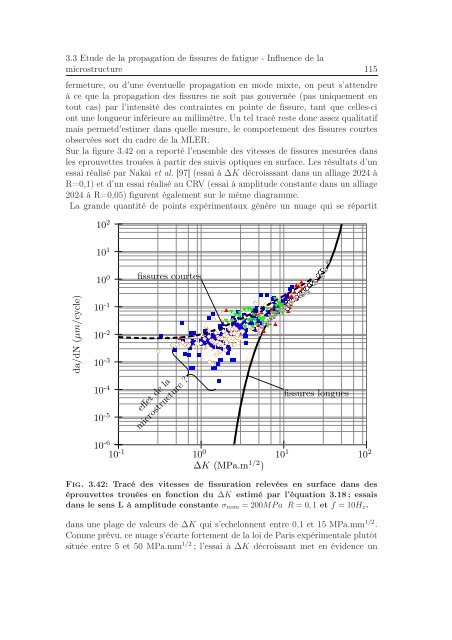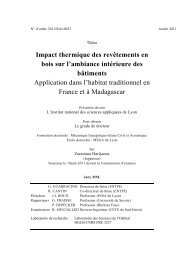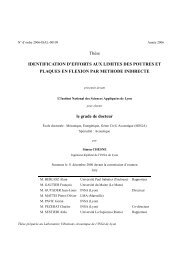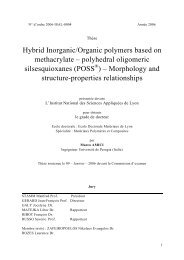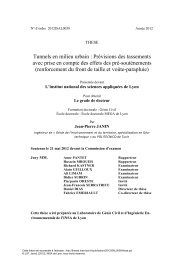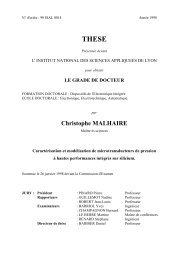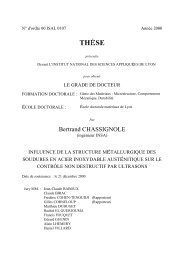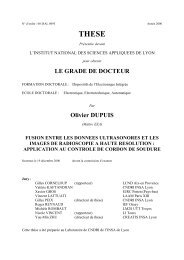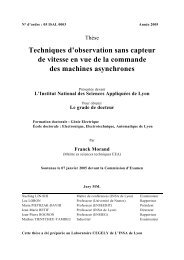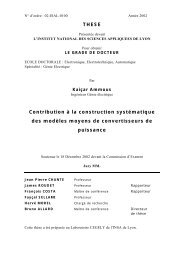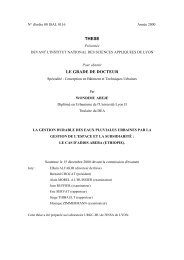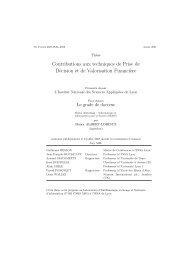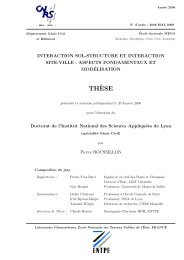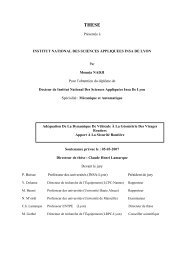Identification des mécanismes de fissuration dans un alliage d ...
Identification des mécanismes de fissuration dans un alliage d ...
Identification des mécanismes de fissuration dans un alliage d ...
Create successful ePaper yourself
Turn your PDF publications into a flip-book with our unique Google optimized e-Paper software.
3.3 Etu<strong>de</strong> <strong>de</strong> la propagation <strong>de</strong> fissures <strong>de</strong> fatigue - Influence <strong>de</strong> la<br />
microstructure 115<br />
fermeture, ou d’<strong>un</strong>e éventuelle propagation en mo<strong>de</strong> mixte, on peut s’attendre<br />
à ce que la propagation <strong><strong>de</strong>s</strong> fissures ne soit pas gouvernée (pas <strong>un</strong>iquement en<br />
tout cas) par l’intensité <strong><strong>de</strong>s</strong> contraintes en pointe <strong>de</strong> fissure, tant que celles-ci<br />
ont <strong>un</strong>e longueur inférieure au millimètre. Un tel tracé reste donc assez qualitatif<br />
mais permetd’estimer <strong>dans</strong> quelle mesure, le comportement <strong><strong>de</strong>s</strong> fissures courtes<br />
observées sort du cadre <strong>de</strong> la MLER.<br />
Sur la figure 3.42 on a reporté l’ensemble <strong><strong>de</strong>s</strong> vitesses <strong>de</strong> fissures mesurées <strong>dans</strong><br />
les eprouvettes trouées à partir <strong><strong>de</strong>s</strong> suivis optiques en surface. Les résultats d’<strong>un</strong><br />
essai réalisé par Nakai et al. [97] (essai à ∆K décroisssant <strong>dans</strong> <strong>un</strong> <strong>alliage</strong> 2024 à<br />
R=0,1) et d’<strong>un</strong> essai réalisé au CRV (essai à amplitu<strong>de</strong> constante <strong>dans</strong> <strong>un</strong> <strong>alliage</strong><br />
2024 à R=0,05) figurent également sur le même diagramme.<br />
La gran<strong>de</strong> quantité <strong>de</strong> points expérimentaux génère <strong>un</strong> nuage qui se répartit<br />
10 2 10 -1 10 0 10 1 10 2<br />
da/dN (µm/cycle)<br />
10 1<br />
10 0<br />
10 -1<br />
10 -2<br />
10 -3<br />
10 -4<br />
10 -5<br />
fissures courtes<br />
◽<br />
<br />
effet <strong>de</strong> la<br />
microstructure ?<br />
⊕•<br />
• •• ⊕•<br />
<br />
⊕•<br />
<br />
<br />
<br />
<br />
<br />
<br />
<br />
<br />
• •• • ••• • •••••• ⊕ •<br />
⊕ • ⊕• <br />
•<br />
<br />
<br />
<br />
<br />
<br />
<br />
<br />
<br />
<br />
<br />
<br />
<br />
<br />
<br />
<br />
<br />
<br />
<br />
<br />
<br />
<br />
<br />
• • •••••••••••• ⊕ ⊕⊕⊕⊕⊕⊕⊕⊕⊕⊕⊕⊕⊕ ⊕•<br />
<br />
<br />
<br />
<br />
<br />
<br />
<br />
<br />
<br />
<br />
◽<br />
◽<br />
◽ ◽<br />
◽ ◽<br />
◽<br />
◽ ◽ ◽ ◽ ◽ ◽<br />
◽ ◽<br />
◽<br />
◽ ◽<br />
◽ ◽◽◽ ◽ ◽◽ ◽ ◽<br />
◽ ◽ ◽ ◽ ◽<br />
◽ ◽◽ ◽ ◽◽<br />
◽ ◽◽<br />
◽◽◽◽◽ ◽<br />
◽<br />
◽ ◽ ◽ ◽<br />
◽<br />
◽<br />
◽ ◽<br />
◽ ◽ ◽<br />
◽◽<br />
◽ ◽ ◽ ◽ ◽ ◽ ◽ ◽<br />
◽<br />
◽ ◽ ◽ ◽ ◽ ◽ ◽ ◽<br />
◽ ◽ ◽<br />
◽ ◽ ◽<br />
◽ ◽ ◽◽<br />
◽ ◽ ◽ ◽ ◽ ◽<br />
◽<br />
◽ ◽ ◽ ◽ ◽ ◽ ◽ ◽ ◽ ◽ ◽ ◽<br />
◽<br />
◽<br />
<br />
<br />
<br />
<br />
<br />
<br />
<br />
<br />
<br />
<br />
<br />
<br />
<br />
<br />
<br />
<br />
<br />
<br />
<br />
<br />
<br />
<br />
<br />
<br />
fissures longues<br />
10 -6<br />
∆K (MPa.m 1/2 )<br />
Fig. 3.42: Tracé <strong><strong>de</strong>s</strong> vitesses <strong>de</strong> <strong>fissuration</strong> relevées en surface <strong>dans</strong> <strong><strong>de</strong>s</strong><br />
éprouvettes trouées en fonction du ∆K estimé par l’équation 3.18; essais<br />
<strong>dans</strong> le sens L à amplitu<strong>de</strong> constante σ nom = 200MPa R = 0,1 et f = 10H z .<br />
<strong>dans</strong> <strong>un</strong>e plage <strong>de</strong> valeurs <strong>de</strong> ∆K qui s’echelonnent entre 0,1 et 15 MPa.mm 1/2 .<br />
Comme prévu, ce nuage s’écarte fortement <strong>de</strong> la loi <strong>de</strong> Paris expérimentale plutôt<br />
située entre 5 et 50 MPa.mm 1/2 ; l’essai à ∆K décroissant met en évi<strong>de</strong>nce <strong>un</strong>


